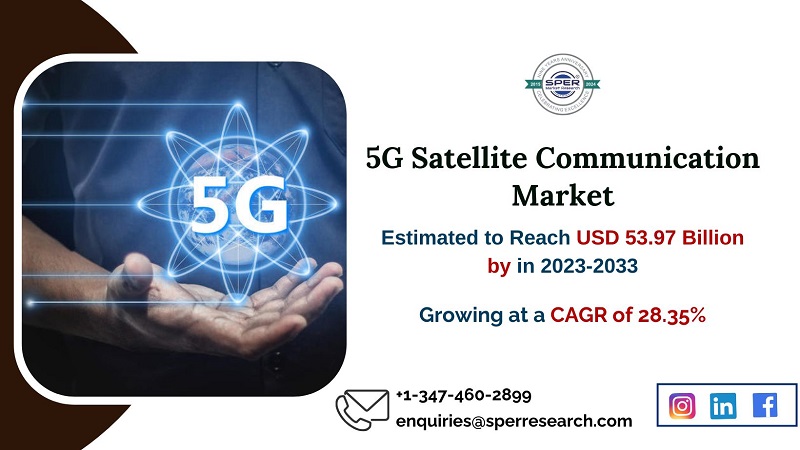5G satellite communication, also known as 5G Non-Terrestrial Network (NTN), integrates satellite technology within the 5G infrastructure, offering worldwide connectivity, particularly in remote and underserved regions. This system utilizes a mix of satellite constellations along with ground-based networks to facilitate smooth communication. It expands connectivity to areas where conventional terrestrial networks are absent or inconsistent, making it crucial for disaster relief and rural connectivity. Innovations in Low-Earth Orbit (LEO) satellites permit lower latency and greater bandwidth, supporting uses such as enhanced mobile broadband (eMBB). 5G satellites can supplement current cellular networks, delivering backhaul solutions and improving overall network dependability. This merging of satellite and terrestrial technologies is set to transform global communications, fostering a more interconnected world.
According to SPER Market Research, ‘5G Satellite Communication Market Size- By Type, By End User – Regional Outlook, Competitive Strategies and Segment Forecast to 2033′ states that the Global 5G Satellite Communication Market is estimated to reach USD 53.97 billion by 2033 with a CAGR of 28.35 %.
DRIVERS: 5G satellites offer extensive connectivity, especially in rural and inadequately served areas where conventional terrestrial networks fall short. This improves access to communication and facilitates various applications, such as IoT and self-driving vehicles. Improvements in Low Earth Orbit (LEO) satellites provide reduced latency and increased data transmission speeds, which are critical for real-time technologies like smart cities and autonomous driving. LEO satellites revolve closer to Earth, significantly minimizing communication delays.5G satellites improve the current terrestrial networks, guaranteeing uninterrupted communication even in difficult conditions. This blended strategy provides greater coverage and dependability. Enhanced financial support from governments for space-based communication technologies fosters the creation of LEO satellite constellations, highlighting their significance for connectivity in the future.
RESTRAINTS: The combination of satellite and terrestrial networks frequently results in spectrum overlap, leading to possible interference. Since both systems function within designated frequency bands, the growing demand for bandwidth elevates the likelihood of co-channel and adjacent channel interference, making effective spectrum management more challenging. Satellite communications, especially those that utilize geostationary satellites, face increased latency because of the lengthy distances signals need to traverse. This latency can pose a considerable barrier for applications that depend on real-time communication, such as online gaming or video conferencing. Setting up satellite infrastructure and keeping it maintained can incur significant expenses, which might discourage investment from smaller firms or startups in the telecommunications industry.
Request For Free Sample Report @ https://www.sperresearch.com/report-store/5g-satellite-communication-market.aspx?sample=1
The market for global 5G satellite communication is dominated by North America due to significant investments in satellite infrastructure and the rollout of 5G networks. Some of its key players are- OneWeb, Hughes Network Systems, Qualcomm, Inmarsat, SpaceX.
5G Satellite Communication Market Segmentation:
By Solution Type: Based on the Solution Type, the Global 5G Satellite Communication Market is segmented as; Backhaul and Tower Feed, Trunking, Head-End Feed, Communication on the Move, and Hybrid Multiplay.
By Orbit: Based on the Orbit, the Global 5G Satellite Communication Market is segmented as; Geosynchronous Earth orbit (GEO), Medium Earth Orbit (MEO), and Low Earth Orbit (LEO).
By Spectrum Band: Based on the Spectrum Band, the Global 5G Satellite Communication Market is segmented as; L and S Bands (1-4 GHZ), C and X Bands (4-12 GHZ), Ku and Ka Bands (12-40 GHZ).
By Service: Based on Service, the Global 5G Satellite Communication Market is segmented as; Mobile Broadband, Defence and Government Mission- Critical Communication, and Satellite IoT.
By End-user: Based on the End User, the Global 5G Satellite Communication Market is segmented as; Defence, Government, Commercial, and Consumer.
By Region: This report also provides the data for key regional segments of North America, Europe, Asia Specific, the Middle East and Africa, South America, and Others.
For More Information, refer to below link: –
5G Satellite Communication Market Forecast
Related Reports:
Contact Us:
Sara Lopes, Business Consultant — USA
SPER Market Research
enquiries@sperresearch.com
+1–347–460–2899
